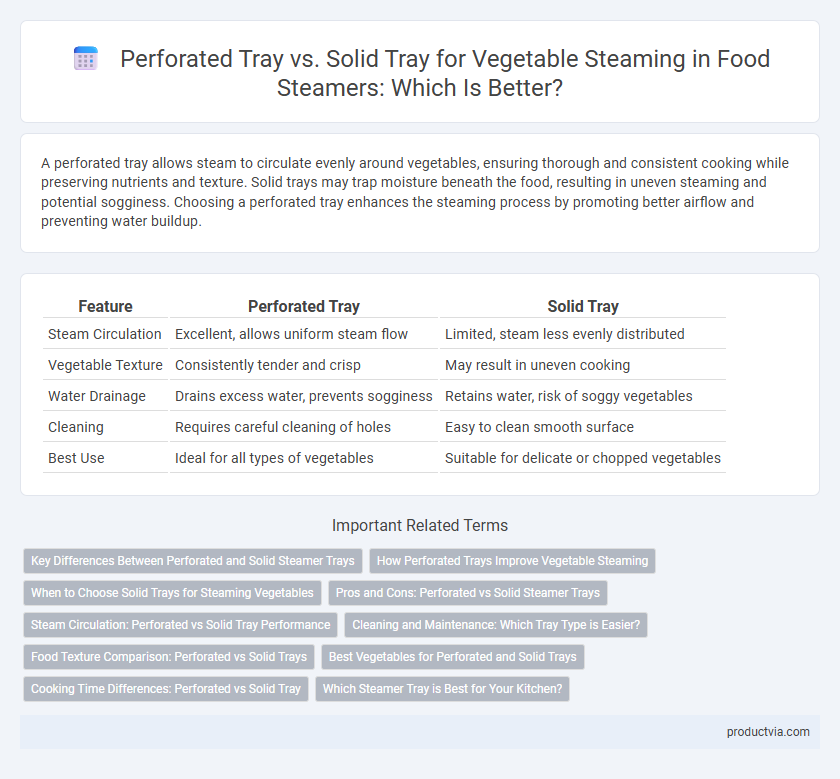A perforated tray allows steam to circulate evenly around vegetables, ensuring thorough and consistent cooking while preserving nutrients and texture. Solid trays may trap moisture beneath the food, resulting in uneven steaming and potential sogginess. Choosing a perforated tray enhances the steaming process by promoting better airflow and preventing water buildup.
Table of Comparison
| Feature | Perforated Tray | Solid Tray |
|---|---|---|
| Steam Circulation | Excellent, allows uniform steam flow | Limited, steam less evenly distributed |
| Vegetable Texture | Consistently tender and crisp | May result in uneven cooking |
| Water Drainage | Drains excess water, prevents sogginess | Retains water, risk of soggy vegetables |
| Cleaning | Requires careful cleaning of holes | Easy to clean smooth surface |
| Best Use | Ideal for all types of vegetables | Suitable for delicate or chopped vegetables |
Key Differences Between Perforated and Solid Steamer Trays
Perforated trays in food steamers allow steam to circulate evenly around vegetables, ensuring consistent cooking and maintaining texture and nutrients. Solid trays, while easier to clean and suitable for steaming delicate items, may result in uneven steam distribution and longer cooking times. Choosing between perforated and solid trays depends on the type of vegetables and desired cooking efficiency.
How Perforated Trays Improve Vegetable Steaming
Perforated trays enhance vegetable steaming by allowing steam to circulate evenly around the food, ensuring consistent cooking and preserving nutrients. The holes facilitate efficient moisture and heat distribution, preventing sogginess while maintaining vegetable texture. This design also reduces cooking time compared to solid trays, which block steam flow and can lead to unevenly cooked vegetables.
When to Choose Solid Trays for Steaming Vegetables
Solid trays are ideal for steaming delicate vegetables like leafy greens or small cuts that might fall through perforations, ensuring even cooking without losing pieces. These trays retain more moisture, creating a gentle steaming environment that prevents overcooking and texture degradation. Choose solid trays when preparing soft or finely chopped vegetables that require gentle heat and consistent moisture retention.
Pros and Cons: Perforated vs Solid Steamer Trays
Perforated steamer trays offer superior steam circulation, ensuring even cooking and preserving the nutrients and texture of vegetables. Solid trays, while limiting steam flow, are better suited for steaming foods with smaller pieces or when collecting juices for sauces is desired. Choosing between perforated and solid trays depends on the desired cooking outcome, with perforated trays excelling in uniform steaming and solid trays providing versatility for different culinary techniques.
Steam Circulation: Perforated vs Solid Tray Performance
Perforated trays enhance steam circulation by allowing hot steam to flow freely around vegetables, ensuring uniform cooking and faster steaming times. Solid trays restrict steam flow to the surface of the vegetables, potentially causing uneven cooking and longer steaming durations. Optimizing steam circulation with perforated trays results in better texture retention and nutrient preservation during the steaming process.
Cleaning and Maintenance: Which Tray Type is Easier?
Perforated trays for vegetable steaming allow water and food particles to pass through, which can result in more thorough cooking but may require frequent cleaning to prevent residue buildup in the holes. Solid trays offer a flat surface that is easier to wipe clean, reducing the risk of trapped food debris and simplifying maintenance. Choosing a solid tray typically results in faster cleaning and less frequent upkeep compared to perforated trays.
Food Texture Comparison: Perforated vs Solid Trays
Perforated trays promote even steam circulation, preserving the crispness and natural texture of vegetables by allowing moisture to escape effectively. Solid trays trap steam beneath the vegetables, resulting in a softer, sometimes mushier texture due to condensation buildup. Choosing between perforated and solid trays depends on the desired vegetable texture: perforated for firmness and solid for tenderness.
Best Vegetables for Perforated and Solid Trays
Perforated trays excel at steaming leafy greens, broccoli, and asparagus by allowing even steam circulation and faster cooking. Solid trays are better suited for firmer vegetables like potatoes, carrots, and squash, retaining moisture and preventing small pieces from falling through. Choosing the right tray enhances nutrient retention and texture based on vegetable type.
Cooking Time Differences: Perforated vs Solid Tray
Perforated trays allow steam to circulate directly around vegetables, significantly reducing cooking time compared to solid trays by promoting even heat distribution. Solid trays block some steam flow, resulting in longer steaming durations as heat must transfer through the tray material to reach food. Choosing a perforated tray enhances efficiency and preserves more nutrients by shortening exposure to heat.
Which Steamer Tray is Best for Your Kitchen?
Perforated trays allow steam to circulate evenly around vegetables, ensuring faster cooking and better nutrient retention, making them ideal for leafy greens and delicate items. Solid trays provide a stable surface for heavier or smaller vegetables, preventing them from falling through while still allowing some steam to reach the food through side vents. Choosing between perforated and solid steamer trays depends on the types of vegetables you frequently cook and whether you prioritize even steaming or stability in your kitchen setup.
Perforated tray vs Solid tray for vegetable steaming Infographic

 productvia.com
productvia.com